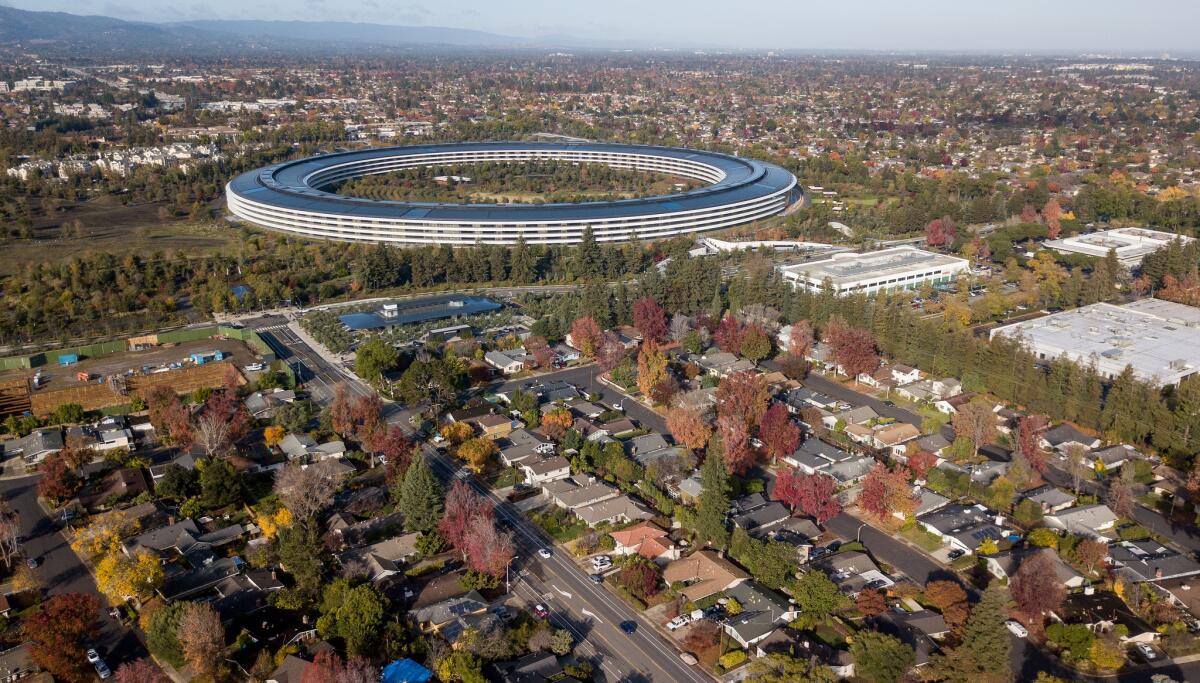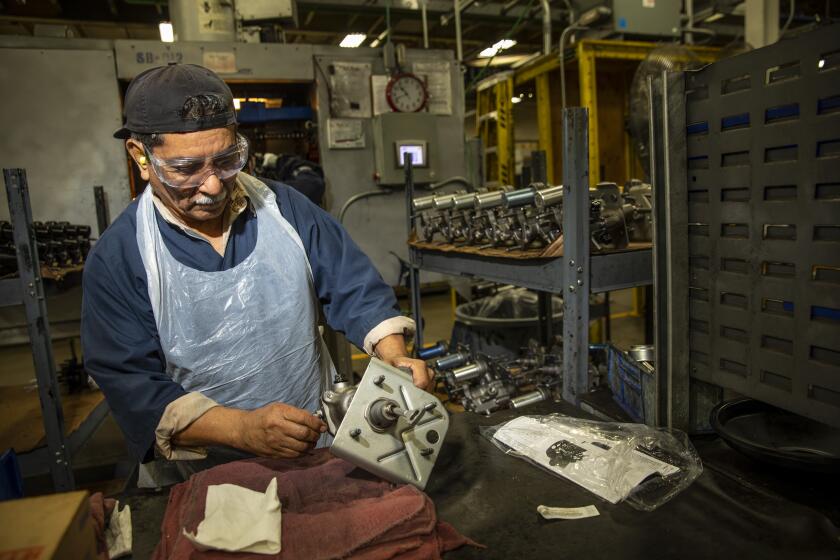California lost more manufacturing jobs to China than any other state, report says

- Share via
California has lost far more jobs to China than any other state, with the San Francisco Bay Area accounting for more than any other region in the nation due to a long outflow of technology manufacturing.
From 2001, when China joined the World Trade Organization, to 2018, the Golden State lost 654,100 jobs to the Asian nation. That’s about double the next highest state loss, Texas’ 334,800 jobs, according to a report released Thursday by the Economic Policy Institute, a labor think tank in Washington, D.C.
The study, based on the latest U.S. Census Bureau, and Labor Department data, calculated that among the congressional districts that lost the most jobs to China, six of the top 10 were in California. Four of those districts were in the Bay Area and Silicon Valley — the 15th, 17th, 18th and 19th districts — where 80% or more of the lost jobs were in the computer and electronics sector.
The Los Angeles area’s 40th Congressional District — encompassing such communities as Downey, East Los Angeles, Commerce and South Los Angeles — was also in the top 10. More than half of its lost jobs were in the garment industry.
San Diego’s 52rd District also ranked in the group, with 80% of lost jobs in computer and electronics manufacturing.
Although much of the attention surrounding President Trump’s trade war has focused on the Midwest, the West Coast was heavily affected by the surge in Chinese manufacturing that led to those trade tensions.
“California has been particularly hard hit because, surprisingly, the hardest hit industries have been in electronics,” said Robert Scott, director of trade and manufacturing research at the Economic Policy Institute and coauthor of the report with data analyst Zane Mokhiber.
“You may think of China as being a low-tech, labor-intensive economy, but they moved very rapidly upscale from textiles and apparel into high-tech goods, computers, telephones, electronic products, video screens — and that’s the largest single industry in terms of job loss to China.”
Overall, the U.S. goods trade deficit with China grew from $83 billion in 2001 to $419.5 billion in 2018, according to the report. Computers and electronics accounted for 44% of the growth, Scott said.
California wineries were expanding into China’s big wine market. Trump’s trade war is destroying their plans.
The Economic Policy Institute, along with its allies in organized labor, has long criticized unfettered free trade, opposing China’s entry into the World Trade Organization that was backed by President Clinton. But the report stops short of endorsing Trump’s trade policies.
“The U.S. trade deficit with China rose from $347 billion in 2016 to $420 billion in 2018, an increase of 21%,” the report noted. “U.S. jobs displaced by China trade deficits increased from nearly 3 million in 2016 to 3.7 million in 2018 — a total of more than 700,000 jobs lost or displaced in the first two years of the Trump administration.”
In an interview, Scott praised Trump’s tariffs on steel and aluminum as “effective because China is such a big player and has played such a negative role in the devastation of those two industries. But the across-the-board tariffs that he imposed on half or more of our imports from China have not helped…. China is shipping us more goods through other countries like Vietnam, Malaysia and Singapore.”
Although the U.S. trade deficit with China declined last year through November, the drop was due to fracking-induced U.S. oil exports, Scott said. The imbalance with non-oil goods, including manufactured goods and farm products, continued to grow.
Only rebalancing exchange rates between the U.S. and other currencies will reduce the trade deficit, he said. “We need to lower the value of the dollar by 25% or 30%.... But Trump hasn’t been willing to tangle with the currency issue because Wall Street likes a strong dollar. That makes it cheap to outsource production.”
If the Economic Policy Institute’s data paint a dire picture of the effect of China trade on American workers, its conclusions are open to dispute by other economists.
“I’m bothered by the assumption that if we weren’t trading as much with China, all these jobs would magically appear in the U.S. economy,” said Christopher Thornberg, an economist with Beacon Economics, a Los Angeles consulting firm serving private industry and public agencies. “No, they wouldn’t. They’d be in Mexico, in Vietnam, in Indonesia.”
Thornberg pointed to California’s record low unemployment, at 3.9% last month, and its record job expansion since the Great Recession. “California’s share of national personal income has never been higher than it is right now,” he said. “We’ve never had it so good.”
Job growth slowed nationwide last year, but it accelerated in California as the state notched a record 118-month employment expansion.
The fact that California lost more manufacturing jobs to China than other states results from the fact that 25 years ago “California was by far and away the dominant manufacturing state in the United States,” Thornberg said. “Los Angeles County all by itself in 1990 had 850,000 jobs in manufacturing. Today, L.A. County has 325,000 manufacturing jobs.
“So because manufacturing was such a larger part of the California’s economy from an absolute standpoint, the losses look larger here.”
The Economic Policy Institute report, however, echoed the contention of many economists that fast-growing service sector jobs are a poor replacement for the better-paid manufacturing jobs that would have remained in the U.S. if not for China’s trade practices.
“Even if increases in demand in other sectors absorb all the workers displaced by trade (which is unlikely), job quality will likely suffer,” the report said. “Many nontraded industries such as retail trade and home healthcare pay lower wages and have less comprehensive benefits than traded-goods industries.”
More to Read
Inside the business of entertainment
The Wide Shot brings you news, analysis and insights on everything from streaming wars to production — and what it all means for the future.
You may occasionally receive promotional content from the Los Angeles Times.












